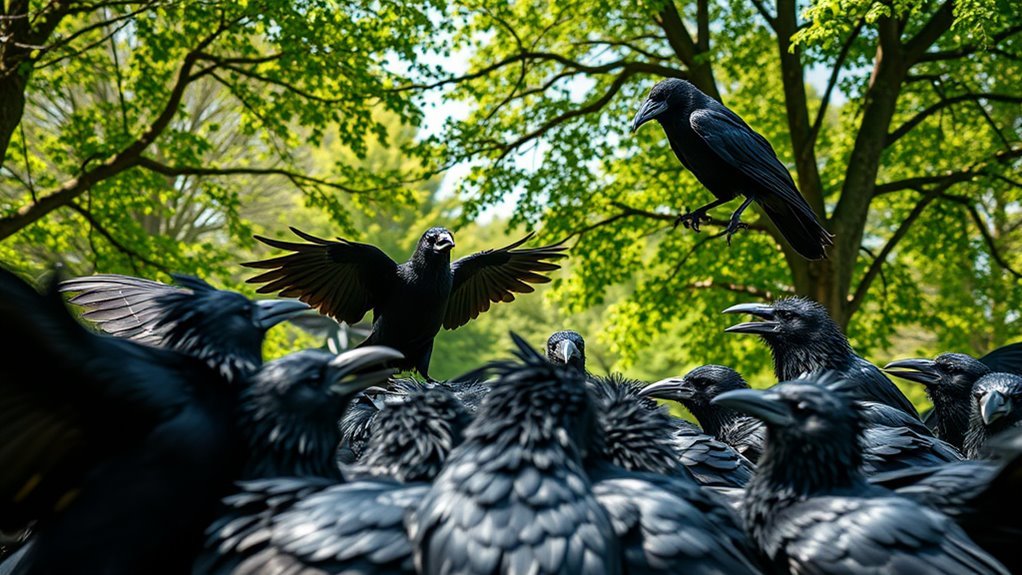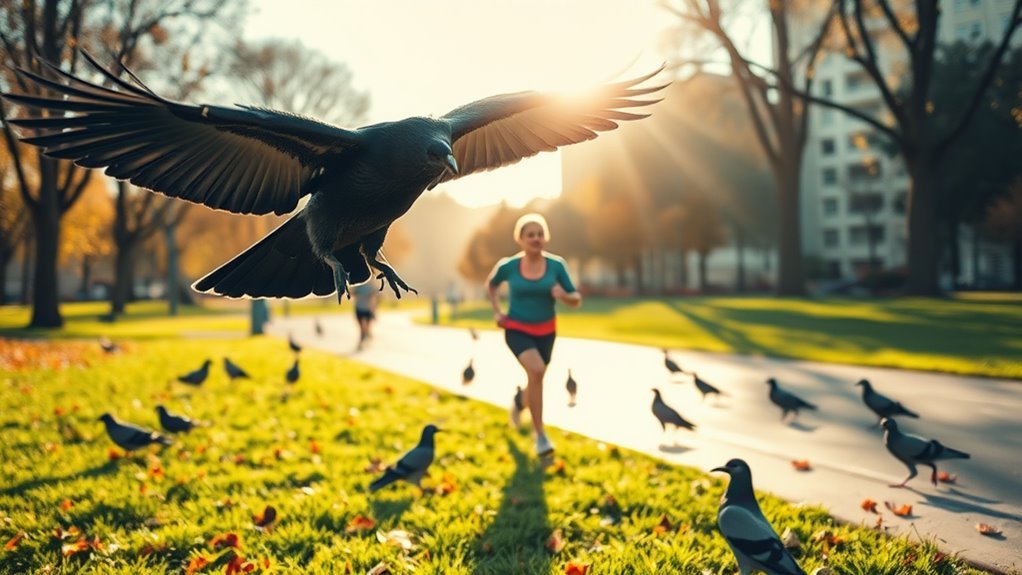Why Do Crows Attack? Understanding Crow Behavior
Crows attack for reasons beyond simple aggression. Their actions are tied to their social structure and survival instincts. Crows are territorial and protective, especially when it comes to their nests. These behaviors show their intelligence and the importance of family groups in their lives. Understanding why crows defend their nests can help explain their fierce behavior. What motivates these intelligent birds to protect their homes?
Key Takeaways
Crows attack to protect their territory. They use loud calls and aggressive actions to scare off intruders and secure their resources. Their aggression is strongest when they guard their nests and young. They may dive-bomb anyone they see as a threat.
Crows have a social structure that helps them work together in defense. This teamwork improves their safety as a group. Crows are also very intelligent. They can remember human faces and connect experiences with those faces. This memory affects how they react to potential threats.
People often misinterpret crow behavior as aggression. This misunderstanding comes from how crows adapt to urban life and their natural instinct to protect resources. Understanding their behavior can help explain why they act this way.
The Social Structure of Crows

Crows aren't solitary birds. They've a complex social structure. This structure is organized and has a clear hierarchy.
Crows work together to meet common goals, such as finding food and protecting their nests. Within a group, some crows take on leadership roles, while others support them in different ways. This shows how their social dynamics function.
The hierarchy among crows can change based on individual strengths, allowing for flexible interactions. This social structure helps crows feel a sense of community.
They rely on each other for support and cooperation to manage their environment effectively.
Territorial Defense Mechanisms
Crows build strong social bonds in their communities and mark clear territories to guard their resources and nesting sites. This behavior is vital for their survival and reduces conflicts during disputes over territory.
When a rival approaches, crows exhibit protective behaviors, such as loud calls, dive-bombing, and gathering together with their flock. These actions show aggression and dominance, reinforcing their claim over the area. Such displays help deter intruders and strengthen social ties within the group.
This behavior highlights how much crows value their shared spaces, showing their need for belonging and security in their social structure.
Nest Protection and Aggression

Crows protect their nests with aggressive behaviors that help their young survive. These birds show strong instincts to defend against threats. You can see crows dive at intruders or hear them make loud calls.
This behavior is especially strong when they've eggs or young chicks in the nest.
As young crows grow, they learn to copy these protective actions. This learning helps them gain the skills needed for survival as adults.
Understanding how crows defend their nests helps us appreciate their role in nature and highlights the need to support their habitats.
The Role of Crow Intelligence
Crows are unique among birds due to their intelligence. Their cognitive abilities help them survive in diverse environments.
- They solve problems effectively.
- They use tools in advanced ways.
- They learn from each other.
Crows can remember human faces and link them to experiences, whether good or bad.
They don't just pick up sticks; they create tools from different materials, showing their critical thinking skills.
Crows also observe their peers to learn and adapt their behaviors.
This intelligence helps them understand their surroundings better, which aids their survival in various habitats.
Human Interactions and Misunderstandings

Human interactions with crows often arise from misunderstandings. Many people view crows as aggressive or disruptive.
In reality, crows are defending their territory or protecting their young. In urban areas, crows adapt to human presence and scavenge for food. This behavior can seem annoying but is actually a survival strategy.
Crows have complex social structures and communication methods. They aren't hostile; they react to perceived threats.
Understanding crows as intelligent animals helps clarify their actions. By changing your perspective, you can appreciate the unique relationship between humans and these fascinating birds.
Predatory Threats and Anxiety
Crows are smart birds that feel anxiety from predators. They show this anxiety through specific behaviors when they detect danger. Understanding how crows identify threats and what causes them stress can help you appreciate their intelligence.
- Crows make loud cawing sounds to warn others of danger.
- Their feathers may stand up, signaling stress.
- They often gather together to chase away threats.
These behaviors demonstrate how crows communicate and work together to protect each other.
Seasonal Behavior Patterns
Crows change their behavior with the seasons. During mating season, they show more aggression and territorial behavior to protect their nests. They become more vocal to warn rivals.
In the fall, food becomes scarce, so crows search for food more actively. They form larger groups to find resources, which can lead to increased competition and more aggressive interactions.
Understanding these seasonal patterns helps us see how crows adapt to their environment. Observing these changes deepens our connection to the crow community around us.
Communication and Warning Calls
Crows communicate in clear and distinct ways, which helps them stay connected and safe. They use different calls to warn each other about various predators. Their alarm signals alert the group to potential dangers.
Crows also make coordinated sounds to strengthen their social bonds. They learn from each other and can mimic sounds to improve their communication.
These vocalizations share important information about threats and food. Observing these signals reveals how crows work together and their intelligence.
Understanding their communication helps you appreciate crows more and feel a stronger connection to these fascinating birds.
The Importance of Family Groups
Family groups are vital for the social structure of crows. They help crows survive and thrive in their environments.
These groups create strong bonds that enhance caregiving among members. For example, adult crows often share tasks like feeding young or guarding the nest. This teamwork increases the survival chances of chicks and strengthens the group's unity.
In stressful situations, the collective watchfulness of family members helps protect against threats, ensuring a safer setting for everyone.
Understanding these family ties provides insight into how crows face challenges, supporting their lineage and community well-being.
Understanding Aggressive Displays
Crows use aggressive displays to communicate within their social groups. These behaviors play a key role in their interactions.
Here are some important actions to observe:
- Mobbing behavior: Crows work together to scare away predators or threats.
- Aggressive postures: They puff up their feathers and caw loudly to show dominance.
- Vocalizations: Crows make specific sounds to alert their group about danger.
When you see crows displaying these behaviors, remember that they're engaging in important social interactions.
These actions help crows build strong communities, which support their survival and social bonds. Observing these behaviors can enhance your appreciation for crows and their social dynamics.
Frequently Asked Questions
Do Crows Remember Human Faces for Future Encounters?
Crows remember human faces. They can connect people with past experiences. This ability helps them understand human behavior. As a result, crows adjust their reactions based on these memories.
Can Crows Recognize Emotions in Other Animals?
Crows can recognize the emotions of other animals. This shows their ability for empathy. They can respond to the feelings of different species. This skill highlights their intelligence and makes them unique among birds. It is interesting to observe how crows interact with other animals based on their emotional states.
What Season Are Crows Most Aggressive?
Crows are most aggressive during their nesting season, which usually occurs in spring. During this time, they protect their nests and young from threats. This behavior makes them territorial and leads to confrontations with perceived dangers. Their protective nature helps ensure the safety of their offspring and strengthens social bonds within their flock.
Do Crows Hold Grudges Against Other Birds?
Crows hold grudges, especially during competition with other birds. They can recognize individual birds and remember past interactions. This ability affects their relationships and behaviors over time, leading to acts of retaliation against birds they see as threats. Crows' social behaviors show that they have complex interactions within their communities, which makes them fascinating creatures to observe.
How Do Crows Respond to Environmental Changes?
Crows change their behavior in response to environmental changes. They adjust their migration patterns and choose new habitats. These shifts show their resilience and problem-solving skills. Crows can thrive in different conditions, highlighting their intelligence and adaptability. Their ability to move to new areas helps them survive and find food, making them fascinating birds to observe.

Ava is a bird enthusiast and nature lover who has spent countless hours observing and learning about the fascinating world of birds. With a passion for sharing her knowledge and inspiring others to appreciate the beauty of birds, Ava writes about her experiences and insights on avianadmirer.com.







